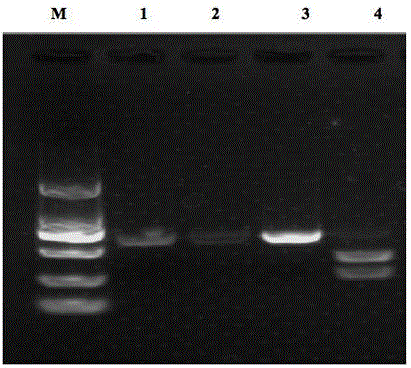PCR-RFLP (Polymerase Chain Reaction-Restriction Fragment Length Polymorphism) method for differentiating duck circovirus from goose circovirus
A PCR-RFLP, duck circovirus technology, applied in the field of molecular biology, can solve problems such as cross-species transmission without corresponding reserve detection methods, and achieve the effects of high efficiency and accuracy, and simple identification methods
- Summary
- Abstract
- Description
- Claims
- Application Information
AI Technical Summary
Problems solved by technology
Method used
Image
Examples
Embodiment 1
[0025] 1. Virus strains: duck circovirus (GenBank accession number: GQ423744) and goose circovirus (GenBank accession number: GU320569) were isolated, identified and preserved by the Institute of Animal Husbandry and Veterinary Medicine, Fujian Academy of Agricultural Sciences.
[0026] 2. Primer design and synthesis
[0027] Primers P1 and P2 were designed according to the NS gene characteristics of duck circovirus and goose circovirus, wherein the sequences of primers P1 and P2 are: upstream primer P1: 5'- CATGATGGGCAGTGGCTTCCT -3', downstream primer P2: 5'- ACCTCCGTCTTCCAATCA -3' .
[0028] 3. PCR amplification
[0029] The genomic DNA of duck circovirus and goose circovirus was extracted by conventional methods. Using the designed specific primers P1 and P2 for PCR amplification, the size of the amplified fragment is about 623bp. The amplification system was 50 μL, including 25 μL of 2×GoTaq Master Green Mix, 1 μL of upstream and downstream primers (20 μM / mL), 1 μL o...
PUM
 Login to View More
Login to View More Abstract
Description
Claims
Application Information
 Login to View More
Login to View More - R&D
- Intellectual Property
- Life Sciences
- Materials
- Tech Scout
- Unparalleled Data Quality
- Higher Quality Content
- 60% Fewer Hallucinations
Browse by: Latest US Patents, China's latest patents, Technical Efficacy Thesaurus, Application Domain, Technology Topic, Popular Technical Reports.
© 2025 PatSnap. All rights reserved.Legal|Privacy policy|Modern Slavery Act Transparency Statement|Sitemap|About US| Contact US: help@patsnap.com

